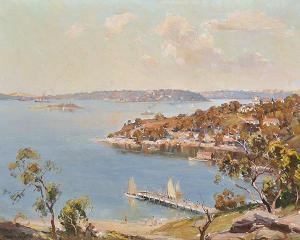Name James Jackson | ||
 | ||
James Ranalph Jackson (1882-1975) was an Australian painter, perhaps best known for painting views of Sydney harbour. Today, his work hangs in public galleries in both Australia and New Zealand. The Art Gallery of New South Wales has 16 of his paintings, however none are currently on display.
Contents
Background
Jackson was born on 3 July 1882 at Bunnythorpe, some ten kilometers north of Palmerston North, New Zealand. His father was George Albert Jackson and his mother was Mary Ann Julia Leach. George Jackson was a farmer from England and Mary Ann Leach was born in India. They had eleven children, including James. After Mary died in 1890, in 1894 the family moved to Darlinghurst, an eastern suburb of Sydney. Sydney Harbour made such an impression on James that it would remain a major motif in his work for the rest of his life.
James left school at an early age to take up an apprenticeship with a decorator. In the evenings James studied drawing at the Art Society of New South Wales. He also briefly attended J. S. Watkins's art school.
Study abroad
In 1906 he wanted to work with Bernard Hall at the National Gallery schools in Melbourne but did not gain admission. Instead Jackson sailed to London. There (Sir) Frank Brangwyn encouraged Jackson to paint thickly and taught him the basic technology. Jackson then spent a year in the Latin Quarter in Paris, studying at the Académie Colarossi and then touring Europe during the summer. He went as far as Venice, where he painted the Rialto Bridge. In Paris he was exposed to Impressionism before he returned to Australia in 1908.
Australian career
After his return to Sydney, Jackson settled on the North Shore of the harbour. There, at the Art Society, he taught drawing and painting from 1917 to 1926. During this period he had his first solo exhibition and got married. The solo exhibition took place in 1920 at the Gayfield Shaw Art Salon. Four years later, on 10 December 1924, he married Dorathea Elizabeth Toovey, one of his students, who later became a noted artist in her own right.
In December 1926 the couple left Sydney to visit Paris and London, and then travel through the Pyrenees to Spain. They returned to Sydney in spring of 1928.
The Great Depression in the early 1930s crimped the family's income. This forced James and Dora to rent out the house they had built at Seaforth, a suburb of northern Sydney, and to move to the country where the cost of living was lower. Still, by 1936 James had a studio at Mosman.
From 1916 to 1933 Jackson was a member of the Australian Art Association, Melbourne. He was one of the first Fellows (1922) of the Royal Art Society of New South Wales, and he became life vice-president in 1965. In 1937 Jackson helped found the Australian Academy of Art and exhibited there until 1946.
In 1942 Jackson joined the camouflage section of the Department of Defence. He remained there until the authorities discovered his true age and dismissed him for being over-age.
In 1947 he and Dora divorced. At the time, they had two children, a son and a daughter. In 1991, his daughter Jacqueline, published a biography of her father.
After his divorce James lived alone and continued to paint. He finally died in Sydney on 9 September 1975.
Art
While living on the North Shore, James painted many landscapes and seascapes of Sydney harbour, some in oils and some in water colour. His early work showed the influence of Impressionism. Then when he lived in the countryside during the Great Depression, he painted landscapes.
